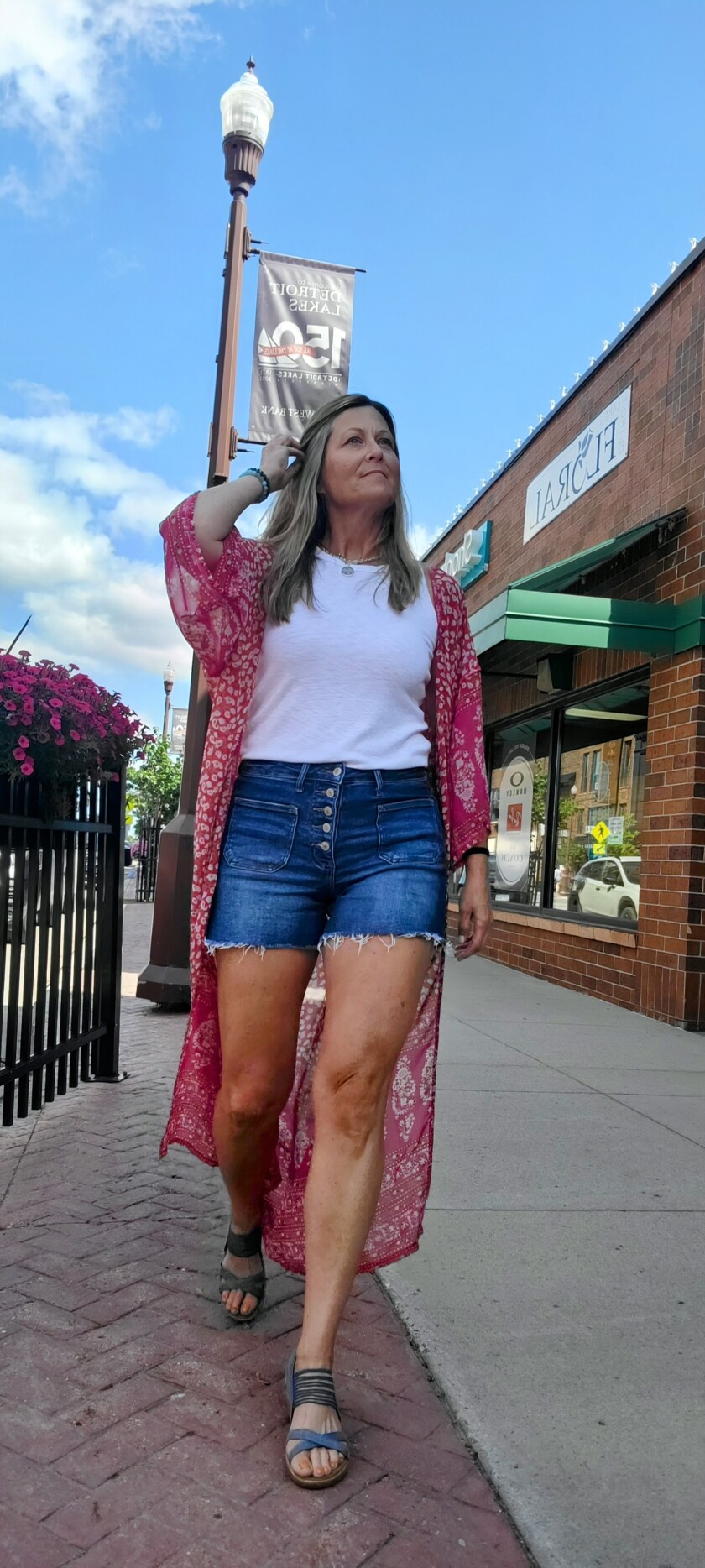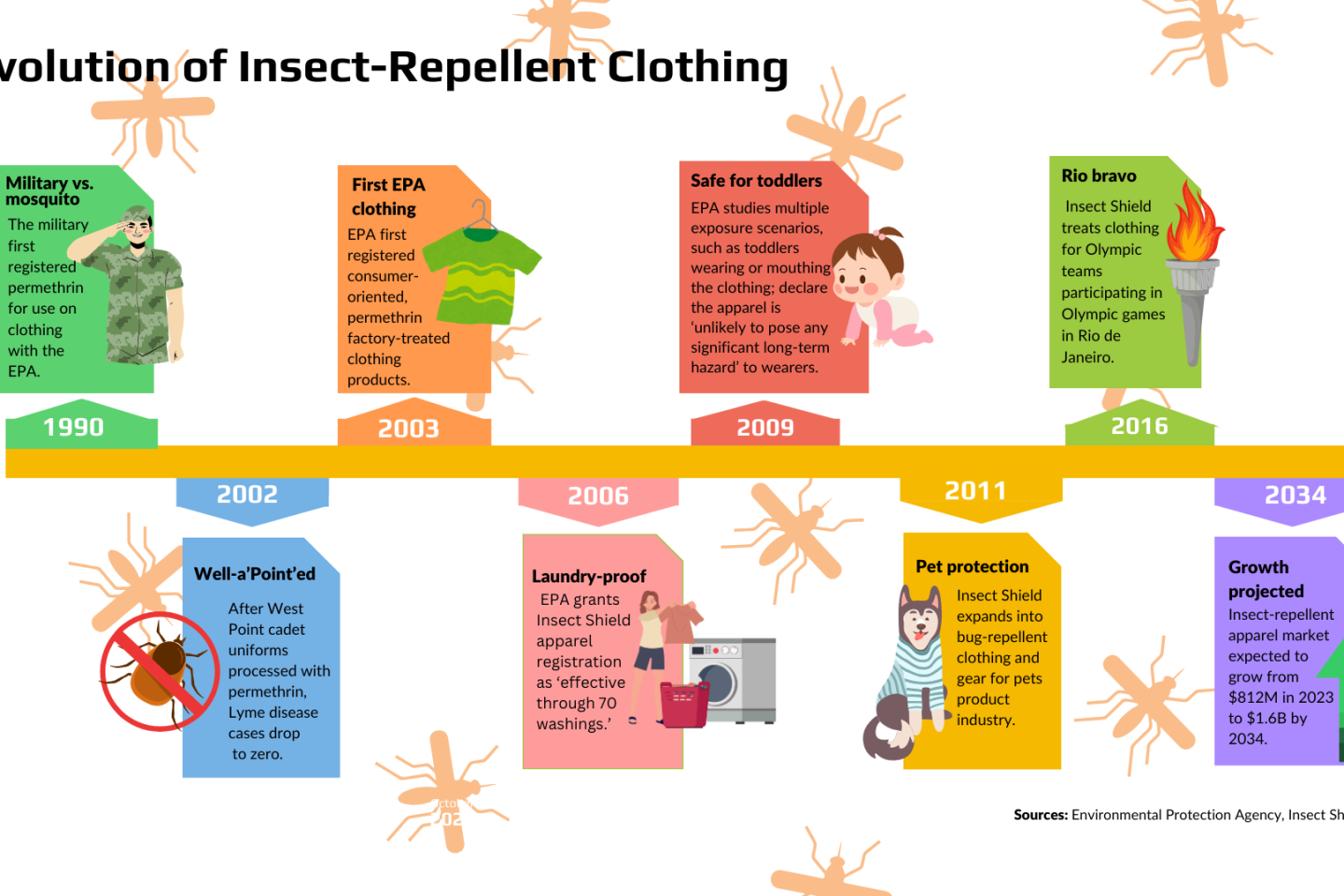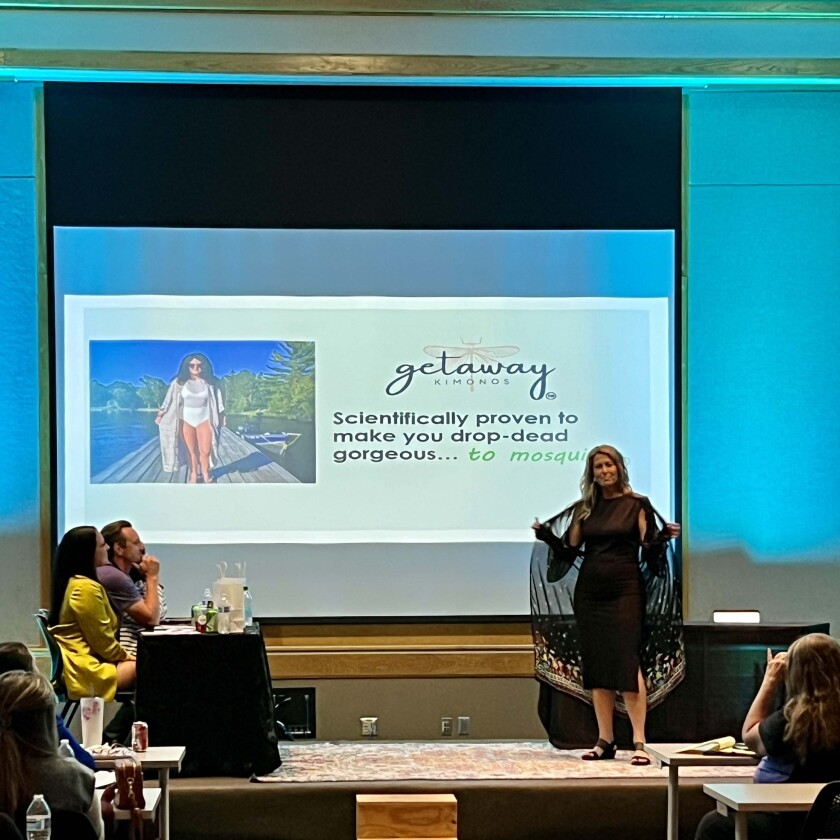DETROIT LAKES, Minn. — For years, those obnoxious party-crashers seemed to ruin every summertime gathering that Barb Owen-Boerger attended.
There were the trips to the beach in International Falls, Minnesota, when the black flies inflicted multiple painful bites.
ADVERTISEMENT
Or the lakeside yoga classes she taught on summer evenings, which went from zen to zilch when the mosquitoes descended.
Owen-Boerger thought there had to be a better way to deal with Minnesota’s buzzing, biting, ever-growing insect population.
Eventually, she found an answer by creating Getaway Kimonos. The garments are as sheer, pretty and lightweight as any other swimsuit cover-up, but contain fabric treated with a safe, EPA-approved insecticide that kills any mosquito, fly, tick or flea that lands on them.
The garments are odorless and will retain their bug-busting powers for at least 70 washes, Owen-Boerger said.

No wonder the tagline for her business is "Our kimonos make you drop-dead gorgeous ... to mosquitoes."
“It's the existing kimonos that are pretty ubiquitous with summer fashion. But we've just turned it into something that has a really useful purpose,” she said.
A buzz-worthy invention
As a Minnesotan with a Bemidji (Minn.) State degree in sports studies and fitness, Owen-Boerger always loved the Great Outdoors.
ADVERTISEMENT
But those outdoor summer activities often bugged her. Literally.
Her search for a solution started in 2016, after bringing her kids to swim in Rainy Lake near her hometown of International Falls.
As she sat on the beach and watched her kids splash and swim in the water, the sun began to set. As if on cue, the black flies swarmed in — and started to bite.

She didn't want to apply a layer of mosquito repellent on everyone when they already were slathered in sunscreen.
She could cover herself with a towel, but it was still 80 degrees outside. There had to be a better solution, she thought, as she watched the flies chase her kids out of the water.
“Initially, my idea was towels that were treated with insect repellent. And it really started to evolve,” she said.
Owen-Boerger discovered Insect Shield, an online company that sells insect-repellent apparel.
ADVERTISEMENT
The company treated their clothing with permethrin, an insecticide so potent that bugs that touch it die. “It disrupts their nervous system. So it causes muscle spasms, paralysis, and most likely they don't live through it,” she said.
It is a buzzkill to mosquitoes, flies and 50 other types of Minnesota menaces, including midges, chiggers, gnats and other ticky situations.
Insect Shield’s proprietary process bonds the insecticide to clothing fibers so effectively that a garment will retain its bug-busting powers even after ironing, bleaching or 70 washes, Owen-Boerger said.

'I don't want to look like Gilligan'
Despite the insecticide’s toxicity to creepy-crawlies, permethrin has been researched thoroughly by the EPA and deemed safe for humans, Owen-Boerger said. “The amount of permethrin allowed in clothing is very low, and scientific studies indicate that human exposure resulting from wearing permethrin factory-treated clothing also is low. Available data show that permethrin is poorly absorbed through the skin,” reads information on the EPA’s website.
In addition to Insect Shield's own clothing line, the company also will treat clothing which customers bought elsewhere for a fee. After bouncing her towel-treatment idea off a company representative, Owen-Boerger learned it wasn’t cost effective, as the thick, absorbent cloth would require much more costly permethrin to repel bugs.
From there, she pivoted to the idea of a thinner, more beach-ready garment, like a kimono or sarong. The loose fit of a kimono also deters bugs because it keeps them from getting close to the skin. And it would add more feminine options in the world of insect-repelling apparel.
ADVERTISEMENT
Through her research, Owen-Boerger noticed that most insect-repelling items out there seemed designed for males. The female options that existed essentially seemed like pastel, slightly downsized versions of men’s fashion.
“I don’t want to look like Gilligan,” she quipped. “I want to look like Ginger.”

Her next step was finding a manufacturer that could produce kimonos and sarongs affordably, as the permethrin process is expensive at the lower volumes she could afford as a fledgling business.
She chose a Chinese e-commerce company that produces a wide range of wholesale products, including apparel.
“When you’re boot-strapping, you just kind of figure things out,” she said.
She ordered three styles of kimonos, then had them treated by Insect Shield. She sold every kimono in her first order.
The garments now sell for $65 on her website, www.getawaykimonos.com, where customers from all over buy them. She also wholesales the garments to retailer accounts.
ADVERTISEMENT
'It's really a public health issue'
As someone whose weekdays are filled working full-time as an optician, Owen-Boerger found her ability to grow her start-up has been limited by both money and time.
But her business received a boost late last summer when she was selected to be one of four finalists for Pitch 412, a local "Shark Tank"-style event in which new businesses pitched their concepts to a panel. “It was great for me because it helped me define my business,” she said. “It was a really good experience.”
Owen-Boerger said she was pleasantly surprised to receive second place, as the other finalists had “remarkable ideas.” But she won $1,000, which happened to be what she needed to place another order for kimonos.

Her next production run will feature kimonos and sarongs in fabrics unique to her company.
While the aesthetic aspect of her product is important to her, so is it’s more pragmatic purpose: the protection against West Nile virus, Lyme disease, Dengue fever and the growing danger of insect-borne illnesses. (Annual reported cases of vector-borne diseases have more than doubled from 2001 to 2023 in the US, according to the Centers of Disease Control.)
“People think it’s just a summer thing because of where we live. And mosquitoes can ruin a good barbecue in a heartbeat,” she said. “But in other parts of the world, it’s really a public health issue. You know, mosquitoes really are the killer of more people every year than any other animal.”
Maybe that’s why the insect-repellent apparel market was over $812 million in 2023 and is projected to balloon to $1.6 billion by 2034, according to Transparency Market Research.
ADVERTISEMENT
It’s why Owen-Boerger plans to double down on her participation in vendor shows, like the Duluth Women's Expo Feb. 22, so she can let people know these aren’t just another pretty beach cover. She said there’s still much education to do at vendor shows and markets to answer those people who wonder why they're more expensive than other kimonos.
“So I'll say, 'Well, do they repel mosquitoes? You can wash them 70 times. Are they treated with something that the US Armed Forces treats all their combat uniforms with?’ And then they get it. Which is why I’m going to go down to the market, so people get it," she said.













